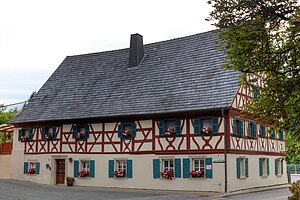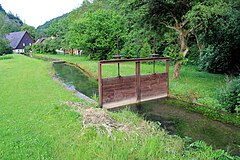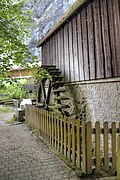Weihersmühle (Weismain)
|
Weihersmühle
City of Weismain
Coordinates: 50 ° 2 ′ 31 ″ N , 11 ° 13 ′ 1 ″ E
|
||
|---|---|---|
| Height : | 395 m above sea level NHN | |
| Residents : | 10 (Feb 19, 2018) | |
| Postal code : | 96260 | |
| Area code : | 09575 | |
|
Location of Weihersmühle in Bavaria |
||
| Weihersmühle
|
||
|---|---|---|
|
The Weihersmühle (actual, historical mill building!) In the Kleinziegenfelder valley |
||
| Location and history | ||
|
|
||
| Coordinates | 50 ° 2 ′ 31 ″ N , 11 ° 13 ′ 1 ″ E | |
| Location |
|
|
| Waters | Weismain | |
| Built | Before 1356 | |
| Shut down | 1974 | |
| Status | Mill technology removed and building converted into a private residence with holiday apartments | |
| technology | ||
| use | Grain and Cutting Mill | |
| Grinder | Formerly three grain milling aisles, a grain beating aisle and a cutting aisle | |
| drive | Watermill | |
| water wheel | Formerly: four water wheels and one on an outbuilding Today: water turbine and water wheel undershot in an outbuilding , each for generating electricity |
|
| Website | schmitt-weihersmuehle.de | |
Weihersmühle is a district with 33 inhabitants of Weismain in the Lichtenfels district . The settlement consists of the eponymous Weihersmühle, a grain mill with outbuildings and the former Landgasthof Zur Forelle with outbuildings. In the Middle Ages and in the early modern period , the Weihersmühle was an important stopping point for travelers in the Kleinziegenfelder valley, through which the important connecting road from Bamberg to Kulmbach ran. Since the 15th century, the mill has the fully licensed and since the 17th century, the brewing right . The name of the mill comes from its location on a pond. In an old document it was called "die weyerssmüll, located under the Arnstein am weyer."
Both the mill and the country inn with the small mill house belonging to it are listed as protected architectural monuments by the Bavarian State Office for Monument Preservation under monument numbers D-4-78-176-155 and D-4-78-176-156 .
Geographical location
The Weihersmühle is located at the bottom of the Kleinziegenfelder valley , right at the beginning of the Kötteler Grund side valley . The valley belongs to the northern foothills of the Franconian Jura in the Franconian Switzerland-Veldenstein Forest Nature Park . Wallersberg is located above the mill . The city center of Weismain is about 5.3 kilometers north.
history
Late Middle Ages
The mill was first mentioned in documents in 1356 or 1357 during a dispute over the fishing water of the "Weizmeun" ( Weismain ) between the knights Albrecht von Punzendorf and Heinrich von Truhendingen von Burg Arnstein .
The year 1448 in the door frame suggests the new construction of the mill building, which from then on was operated as a grain mill at the latest. The builders were possibly the brothers Cunz and Fritz Mülner from Weismain, who inherited the “Weyerssmüll” or “Weierßmül” from their father in 1424. Even then, the mill had its current name after the pond next to it.
From 1475 to 1487, the serving of beer by Georg Weyermüller and Hans Wagner or Weyerßmulner with an official license is handed down. At that time, the beer and bar monopoly was held by the city of Weismain, which unsuccessfully brought an action against the Weihersmühle before the episcopal government in Bamberg . Between 1487 and 1500 the mill belonged to Jörg Weyersmulner from Arnstein and from 1501 to 1503 Heinz Weyermullner . In 1515 the license of the Weihersmühle was confirmed in a document by the prince-bishop's regional court.
Early modern age
In 1602, Prince-Bishop Johann Philipp von Gebsattel granted permission to build a malt and brewing facility in the Weihersmühle. This prompted the Weismainers to file a new lawsuit demanding that the beer should only be served in the neighboring Arnstein, but not in the mill itself. Although the Bamberg Monastery had recognized this compromise, the miller did not adhere to it, so it closed came a lawsuit that the miller won when he invoked the permission granted in 1515.
Almost a hundred years later there was another conflict with the Weismainers in 1694, when Jakob Weyermüller sold large quantities of beer to localities outside of his tapping area. In the process that followed, the miller admitted his offense, which is why his brewing right was not withdrawn. Shortly afterwards he sold beer to Modschiedel. As a result, 20 armed men from Weismain moved to Weihersmühle and reaffirmed their right to be allowed to drink in the region. In the decades that followed, the Weihersmühle was no longer brewing as often, and the number of drinks on offer also declined. The widow of Jakob Weyermüller, who died on October 9, 1647, married Moritz Will, who came from Köttel, so that the mill passed into new family ownership for the first time in over 200 years. With the approval of the then Bamberg prince-bishop Friedrich Karl von Schönborn-Buchheim on September 3, 1745 and the support of the Scheßlitz box office and the forester von Weismain, the then miller Bernhard Rehe had a cutting mill built next to the pond mill in 1746 .
Prince-Bishop Franz Konrad von Stadion und Thannhausen granted the Weihersmühle again the right to brew and drink with a certificate in 1754. The then miller Bernhard Rehr or Rehe then intensified the brewing activities that had been dormant several years earlier and opened an inn in a building next to the mill, which was expanded into a two-story residential building in 1798. It is the predecessor of today's inn building. On October 29, 1978 the inn was reopened after the renovation work. In 1801 the mill had 3 grinding courses and a beater . With the acquisition of the mill by the Wagner family, there was a change of ownership. In 1805 Georg Wagner bought the trout waters up to Schammendorf (Weismain) and named the inn Zur Forelle .
19th century until today
In 1832 the Weihersmühle came into the possession of the Tremel family through marriage. In the same year, beer brewing was stopped and beer has been sourced from Weismain ever since. For the year 1850, the mill was named as "residential house with grinding mill and cellar" and "cutting mill with courtyard". The second year engraved on the door frame, "1879", suggests that the building was being renovated. In 1920, the old Gasthof Zur Forelle, which basically dates back to the 15th century, was rebuilt by the Bamberg hunting leaseholder and councilor of commerce, Rudolf Weyermann, in order to do justice to the increasing tourism. The milling operation in the flour mill was carried out until 1974. Since then, a turbine has been generating electricity for its own use with a nominal output of 15 KW in the building used as a residential and holiday home . On the evening of November 30, 2005, an eight meter high mud avalanche broke loose on Wallersberger Berg and destroyed the kitchen extension and parts of the inn's interior. The reason for the mudslide was a leaky water pipe that soaked the slope so that it slipped over a width of 60 meters. This damage could be repaired by spring 2006.
The Tremel family ran the inn until 2008 and continued to operate it after a change of tenant until it was temporarily closed in April 2011. A guesthouse with double rooms has been set up in the mill building for several decades.
Population development
The table shows the population development of Weihersmühle based on individual data.
| year | Residents | source |
|---|---|---|
| 1833 | 6th | |
| 1987 | 9 | |
| 2011 | 4th | |
| 2012 | 3 | |
| 2013 | 33 | |
| 2015 | 50 |
architecture
The mill building is a saddle roof structure , the structure of which mainly dates from the 17th century. A half-timbered upper floor with St. Andrew's crosses and diamonds is located above the massive ground floor . In the middle of the gable is a carved mask , a Biebel (house and guardian spirit ), whose eyes are directed towards the street.
The Landgasthof Zur Forelle is a converted former outbuilding of the mill. Next to the parking lot is the former sawmill , two barn-like gable roof buildings with wooden paneling. The mill wheel, an undershot screw wheel, is used today to generate electricity . Until the new installation of the waterwheel at the Stoffelsmühle in August 2011, it was the only still intact and operated millwheel in the Kleinziegenfelder valley and is freely accessible for viewing.
photos
literature
- Jutta Böhm: Mill bike tour. Routes: Kleinziegenfelder Tal and Bärental , Weismain environmental station in the Lichtenfels district, Weismain / Lichtenfels (Lichtenfels district), 2000, 52 pages (numerous illustrations, canton)
- Ingrid Weiskopf, Karin Raab-Aydin (Eds.): Burgkunstadt, Altenkunstadt, Weismain - Art and Culture - Things worth knowing and interesting yesterday and today , Die Kulturmacher e. V. 2000, no ISBN
Web links
See also
List of mills on the Weismain and Krassach rivers
Individual evidence
- ↑ a b c d e f g h i j k l m n o p Böhm (2000), p. 23.
- ↑ a b c Weiskopf; Raab-Aydin (2000), p. 193
- ↑ Mühle, Weihersmühle 1 , geodaten.bayern.de, accessed on December 8, 2012
- ↑ Gasthof, Weihersmühle 2 , geodaten.bayern.de, accessed on December 8, 2012
- ↑ a b c d e f g h i j k l m n o p History of the Weihersmühle , landgasthof-weihersmuehle.de, accessed on April 7, 2011 (offline since summer 2011)
- ↑ a b c d Josef Urban: Leafed through the history books: Stations in the history of Wallersberg, Mosenberg and Weihersmühle . In: Markus Hatzold: Festschrift der Freiwilligen Feuerwehr Wallersberg-Mosenberg , Weismain 2009, p. 43
- ↑ a b c d e f g h i Josef Urban: Leafed through the history books: Stations in the history of Wallersberg, Mosenberg and Weihersmühle . In: Markus Hatzold: Festschrift der Freiwilligen Feuerwehr Wallersberg-Mosenberg , Weismain 2009, pp. 71–79
- ↑ Josef Motschmann: Chronicle of the district of Lichtenfels 2005 . In: Heimatgeschichtliche Zeitschrift für der Landkreis Lichtenfels , Volume 15 - 2006, Verlag Vom Main zum Jura, Eggolsheim 2006, p. 105
- ↑ Pension Schmitt , schmitt-weihersmuehle.de, accessed on 15 October 2012
- ^ Joseph Anton Eisenmann: Geographical description of the Archdiocese of Bamberg: together with a short overview of the suffragan dioceses: Würzburg, Eichstätt and Speyer . Bamberg 1833, p. 511 ( full text in Google Book Search). , P. 485
- ^ Genealogical location directory of the Weihersmühle , gov.genealogy.net, accessed on December 29, 2011
- ↑ Distribution of residents in the city of Weismain on January 1st, 2011 ( page no longer available , search in web archives ) Info: The link was automatically marked as defective. Please check the link according to the instructions and then remove this notice. , stadt-weismain.de, accessed on December 29, 2011 (PDF, offline)
- ↑ Population distribution of the city of Weismain on January 1, 2012 ( Memento from January 5, 2013 in the Internet Archive )
- ↑ Population distribution in the city of Weismain on January 1, 2013 ( Memento from May 18, 2013 in the Internet Archive )
- ↑ Population distribution of the city of Weismain on January 1, 2015 ( Memento from September 23, 2015 in the Internet Archive )








